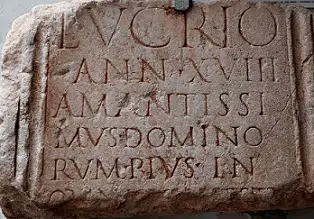 The Greek word epigraphḗ , which can be translated as “inscription,” came into modern Latin as epigraphia . The concept, in Spanish, became epigraphy : this is the name given to the scientific discipline that is dedicated to analyzing inscriptions .
The Greek word epigraphḗ , which can be translated as “inscription,” came into modern Latin as epigraphia . The concept, in Spanish, became epigraphy : this is the name given to the scientific discipline that is dedicated to analyzing inscriptions .
The term inscription , meanwhile, has several uses. On this occasion we will focus on its meaning as a writing that is recorded on a resistant material with the aim of recording something so that it subsists despite the passage of time .
Epigraphy aims to analyze the support, structure, content and function of the inscriptions. Although it is considered a science with autonomy, it is also an auxiliary branch of history .
Experts in this area of knowledge seek to decipher and interpret the inscriptions . In this framework, they also study the materials on which the engravings were made and the purpose of the writings.
It is common for epigraphy to be considered a testimony of the transition of a people from prehistory to history . This is because history begins with the appearance of written documents, so the existence of inscriptions would imply for a culture to leave the prehistoric period behind.
The oldest inscriptions were developed around 3800 BC , when the Sumerians devised cuneiform writing . Today epigraphy investigates inscriptions of multiple kinds: legal, honorific, historical, religious, etc.
The Rosetta Stone , the Tanais Tablets and the Mesha Stele are some of the most famous documents among those studied by epigraphy. These three testimonies are preserved in museums .
Let's start by talking about the Rosetta Stone. It is part of an ancient Egyptian stele made of granodiorite, an igneous rock whose texture makes it similar to granite. On its surface you can see a decree that was inscribed in the year 196 BC in the capital of the ancient Empire of Egypt, Memphis, representing Pharaoh Ptolemy V.
 According to studies by epigraphy experts, we know that its carving process took place in the Hellenistic period and it is believed that it was originally displayed inside a temple, probably in the city of Sais, since it is not known. was at a great distance. Its transfer is estimated to have taken place in the last stage of Antiquity or at the time of the medieval kingdom known as the Mamluk Sultanate of Egypt .
According to studies by epigraphy experts, we know that its carving process took place in the Hellenistic period and it is believed that it was originally displayed inside a temple, probably in the city of Sais, since it is not known. was at a great distance. Its transfer is estimated to have taken place in the last stage of Antiquity or at the time of the medieval kingdom known as the Mamluk Sultanate of Egypt .
On the other hand, we have the two Tanais Tablets , which date back to the 3rd century and were written in Greek in the city of the same name, relatively close to modern-day Rostov-on-Don, in Russia. To provide a more precise context, we must clarify that the population of Tanais included people of Sarmatian and Greek origin .
The inscriptions present on these tablets were of a public nature and were made to commemorate renovation works in the city . Since it is a pair, the epigraphic experts who were in charge of studying them assigned a letter to each one to distinguish them, so we speak of tablet A and tablet B.
Tablet A is damaged and they have not been able to completely reconstruct it. The B, on the other hand, is complete and is known to have been made in the year 220. They were discovered by the archaeologist Pavel Mikhailovich Leontjev in 1853 and are currently exhibited in the Hermitage Museum in Saint Petersburg.
The third document mentioned above is the Stele of Mesha , a stone on which the Moabite king Mesha left a thirty-four-line inscription in the 9th century BC.
